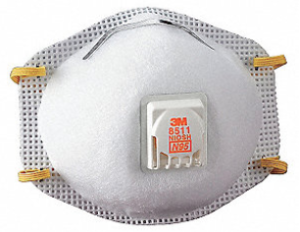
Below are two press releases on the use of N95 respirators/masks.
- from Dr. Ken Cutler at Nevada County Public Health Department
- from the California Department of Public Health
Health Officer Statement on Air Quality and Use of N95 Respirators/Masks
In collaboration with the Northern Sierra Air Quality Management District (NSAQMD) a series of Air Quality Advisories have notified the public of poor air quality conditions in Nevada County resulting from the Camp Fire in Butte County. Conditions are expected to vary but may be in the Very Unhealthy to Hazardous ranges at times. A number of questions have been raised about the use of N95 respirator masks during a wildfire smoke event. The Nevada County Public Health Officer is advising only the appropriate use of N95 respirator masks for those who do not have access to filtered or recirculated air and instead urges people to stay indoors and avoid exposure to smoke. While the use of N95 respirators if properly fitted may help some people who cannot otherwise avoid smoke exposure, the N95 respirators can increase the work of breathing and can exacerbate symptoms in those with respiratory or heart problems. N95 respirator mask use by those with heart and respiratory diseases can be dangerous, and should only be done under a doctor’s supervision. Also, respirators do not come in sizes suitable for children. Since they would not fit well enough to provide a tight face seal, they would not be effective at reducing exposure.
To sign up for the Air Quality Health Advisory email list, please visit www.myairdistrict.com. For regularly updated information on local air quality, please visit www.sparetheair.com (this link not working at publication time…will update as able).
For more on the use of Particulate Respirators (Masks) by the general public and how to use it if chosen, please see: https://www.cdph.ca.gov/Documents/Use%20of%20Particulate%20Respirators%20(Ma sks)%20to%20Protect%20from%20Wildfire%20Smoke%20or%20Ash.pdf
####
Use of Particulate Respirators (Masks) to Protect from Wildfire Smoke or Ash
California Department of Public Health – October 17, 2017
Use of respirators by the general public for protection from wildfire smoke or ash
A respirator is a device that covers your nose and mouth, fits closely to your face, and helps protect your lungs by reducing contaminants in the air you breathe. A respirator called “N95” or “P100” is the most common type for protecting you from particles in smoke or ash. They are available at hardware or home improvement stores and pharmacies.
- The most effective way to protect yourself during wildfire emergencies is to stay indoors or limit your time outdoors when there is smoke in the air. By limiting your exposure in this way, you may not need to wear a respirator.
- If you must be outside for extended periods of time in smoky air or in an ash- covered area, you may benefit from using a tight-fitting respirator to reduce your exposure.
- If you are experiencing adverse effects from breathing in a smoky environment, even indoors, you may benefit from using a tight-fitting respirator.
- If you want to wear a respirator, you should learn how to select and correctly use the respirator. This is very important for get the best protection.Possible risks
- Wearing a respirator can make it harder to breathe. If you have heart or lung problems, ask your doctor before using a respirator.
- If you have difficulty breathing, get dizzy, or have other symptoms while wearing a respirator, go to a place with cleaner air and remove it.
- Wearing a respirator, especially if it’s hot or you are physically active, can increase the risk of heat-related illness. Take breaks often. If you feel dizzy, faint, or nauseous, go to a place with cleaner air, remove the respirator, and seek medical attention.
- Respirators do not come in sizes suitable for children. Since they would not fit well enough to provide a tight face seal, they would not be effective at reducing exposure.
How to use it
- Select N95 or P100 filtering facepiece respirators approved by the National Institute for Occupational Safety and Health (NIOSH). The respirator works by capturing smoke particles in the filter material that makes up the mask as the user inhales. Any leakage around the face seal causes unfiltered air to enter the mask and be inhaled.
- Effective use relies on selecting a size and model that will provide a tight seal between the respirator and user’s face.
- To get a secure fit, place the mask over your nose and under your chin, with one strap placed below the ears and one strap above.
- Throw out the mask when it gets harder to breathe through, or if the inside gets dirty.
- N95 or P100 respirators can help to filter out particles, but they do not remove irritating chemicals contained in smoke.
- To get the most protection from a tight-fitting respirator, users should be clean shaven in the areas where the mask seals to the face.
- 1-strap nuisance dust masks or surgical masks with straps that go around your ears will not protect you from smoke or ash because they are not designed to seal tightly to the face.For more information on worker health and safety in wildfire regions, please visit the California Department of Industrial Relations.
